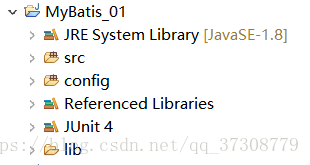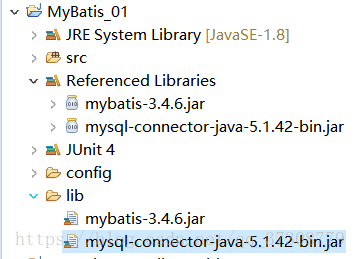1、MyBatis简介
MyBatis 是支持定制化 SQL、存储过程以及高级映射的优秀的持久层框架。MyBatis 避免了几乎所有的 JDBC 代码和手动设置参数以及获取结果集。MyBatis 可以对配置和原生Map使用简单的 XML 或注解,将接口和 Java 的 POJOs(Plain Old Java Objects,普通的 Java对象)映射成数据库中的记录。
2、Mybatis第一个程序
2.1 准备开发环境

2.2 添加jar包
【Mybatis】
mybatis-3.4.6.jar
【MySQL】
mysql-connector-java-5.1.42-bin.jar

2.3 创建数据库和表
数据库名为 mybatis,表名为 tb1_employee。
CREATE TABLE `tb1_employee` (
`id` int(11) NOT NULL AUTO_INCREMENT,
`last_name` varchar(255) DEFAULT NULL,
`gender` char(1) DEFAULT NULL,
`email` varchar(255) DEFAULT NULL,
PRIMARY KEY (`id`)
) ENGINE=InnoDB AUTO_INCREMENT=2 DEFAULT CHARSET=utf8
insert into `tb1_employee`(`id`,`last_name`,`gender`,`email`) values (2,'lhk','1','lhk@qq.com');
2.4 使用Mybatis查询数据
1、创建对应于数据库字段的实体类
package com.lhk.mybatis.beans;
public class Employee {
private Integer id;
private String lastName;
private String email;
private String gender;
public Integer getId() {
return id;
}
public void setId(Integer id) {
this.id = id;
}
public String getLastName() {
return lastName;
}
public void setLastName(String lastName) {
this.lastName = lastName;
}
public String getEmail() {
return email;
}
public void setEmail(String email) {
this.email = email;
}
public String getGender() {
return gender;
}
public void setGender(String gender) {
this.gender = gender;
}
@Override
public String toString() {
return "Employee [id=" + id + ", lastName=" + lastName + ", email=" + email + ",
gender=" + gender + "]";
}
}
2、添加Mybatis的配置文件mybatis-config.xml
<?xml version="1.0" encoding="UTF-8"?>
<!DOCTYPE configuration
PUBLIC "-//mybatis.org//DTD Config 3.0//EN"
"http://mybatis.org/dtd/mybatis-3-config.dtd">
<configuration>
<environments default="development">
<environment id="development">
<transactionManager type="JDBC" />
<!-- 数据库连接的配置信息 驱动,URL,用户名,密码-->
<dataSource type="POOLED">
<property name="driver" value="com.mysql.jdbc.Driver" />
<property name="url" value="jdbc:mysql://localhost:3306/mybatis" />
<property name="username" value="root" />
<property name="password" value="13579" />
</dataSource>
</environment>
</environments>
<!-- 将我们写好的sql映射文件(EmployeeMapper.xml)一定要注册到全局配置文件(mybatis-config.xml)中 -->
<mappers>
<mapper resource="EmployeeMapper.xml" />
</mappers>
</configuration>3、定义操作表的sql映射文件EmployeeMapper.xml
<?xml version="1.0" encoding="UTF-8"?>
<!DOCTYPE mapper
PUBLIC "-//mybatis.org//DTD Mapper 3.0//EN"
"http://mybatis.org/dtd/mybatis-3-mapper.dtd">
<mapper namespace="com.lhk.mybatis.EmployeeMapper">
<!-- namespace:名称空间
id:sql的唯一标识
resultType:返回值类型
#{id}:从传递过来的参数中取出id值
-->
<select id="selectEmp" resultType="com.lhk.mybatis.beans.Employee">
select id,last_name lastname,gender,email from tb1_employee where id = #{id}
</select>
</mapper>4、编写测试代码:执行定义的select语句
package com.lhk.mybatis.test;
import java.io.IOException;
import java.io.InputStream;
import org.apache.ibatis.io.Resources;
import org.apache.ibatis.session.SqlSession;
import org.apache.ibatis.session.SqlSessionFactory;
import org.apache.ibatis.session.SqlSessionFactoryBuilder;
import org.junit.Test;
import com.lhk.mybatis.beans.Employee;
public class MyBatisTest {
/**
* 1、根据xml配置文件(全局配置文件)创建一个SqlSessionFactory对象 有数据源的运行环境信息
* 2、sql映射文件;配置了每一个sql,以及sql的封装规则等。
* 3、将sql映射文件注册在全局配置文件中
* 4、写代码:
* 1)、根据全局配置文件得到SqlSessionFactory;
* 2)、使用sqlSession工厂,获取到sqlSession对象使用他来执行增删改查
* 一个sqlSession就是代表和数据库的一次会话,用完关闭
* 3)、使用sql的唯一标志来告诉MyBatis执行哪个sql。sql都是保存在sql映射文件中的。
*
* @throws IOException
*/
@Test
public void test() throws IOException {
String resource = "mybatis-config.xml";
InputStream inputStream = Resources.getResourceAsStream(resource);
SqlSessionFactory sqlSessionFactory = new SqlSessionFactoryBuilder().build(inputStream);
/*2、获取sqlSession实例,能直接执行已经映射的sql语句*/
SqlSession openSession = sqlSessionFactory.openSession();
try {
/* sql语句的唯一标识
执行sql要用的参数 */ namespace+id
Employee employee = openSession.selectOne("com.lhk.mybatis.EmployeeMapper.selectEmp", 2);
System.out.println(employee);
} finally {
openSession.close(); // 关闭openSession
}
}
}5、运行结果,成功查询出id为2的所有Employee数据





 本文介绍如何使用MyBatis框架进行数据库操作。首先概述了MyBatis的基本概念,随后通过搭建开发环境、创建数据库表、定义实体类、配置MyBatis文件及编写测试代码等步骤,演示了如何实现数据查询。
本文介绍如何使用MyBatis框架进行数据库操作。首先概述了MyBatis的基本概念,随后通过搭建开发环境、创建数据库表、定义实体类、配置MyBatis文件及编写测试代码等步骤,演示了如何实现数据查询。
















 639
639

 被折叠的 条评论
为什么被折叠?
被折叠的 条评论
为什么被折叠?








